Sierra Club Sues on Calico Project
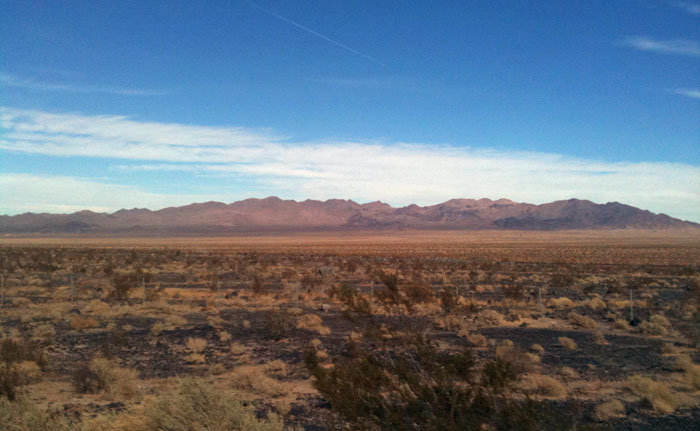
^The sweeping view of the Calico Solar Project site on the alluvial fan below the Cady Mountains.
January 4, 2011 - On December 30, 2010 the Sierra Club filed a petition with the California Supreme Court over violations of the California Environmental Quality Act (CEQA) and Warren Alquist Act over the Calico Solar Project. Tessera Solar had developed the project as a Stirling dish/engine solar thermal power plant, yet due to financial problems undoubtedly stemming from the unreliability of the technology, the parent company NTR of Ireland sold the project rights to K Road, an energy development start-up company that planned to turn most of the project into photovoltaic panels, with a smaller phase remaining as Stirling dishes. The project is still known as Calico Solar Project, and may have to restart both Bureau of Land Management environmental review, and California Energy Commission review (the CEC has responsibility for upholding CEQA).
The Warren Alquist Act requires the California Energy Commission to site thermal power plants in a way that will not violate any laws, and that will ensure plants do not cause "significant, unmitigable, adverse environmental impacts." CEQA ensures long-term protection of the environment, requiring reviews so that the public and responsible officials are alerted to any environmental changes before they have reached ecological point of no return.
Sierra Club's petition states that the project site is important to wildlife and plant species, but that the CEC's "self-imposed artificial deadline" for approval led to impacts on Desert tortoise and other species remaining "significant and unavoided."
The project would radically transform" the entire 4,613 acres from an "undisturbed, remote, biologically rich desert habitat" into a "completely fenced industrial facility," says the petition. "The effects of this transformation on biological resources would be devastating. The Project would result in destruction of all habitat for species on the Project site." We would like to note that the original SunCatcher project by Tessera claimed to be environmentally sensitive by leaving some desert vegetation between dish pedestals, and that creosote shrubs would be mowed. If the project is converted to photovoltaic panels on pedestals, the exact same problems will remain with respect to biological resources and desert habitats.
Tortoise Concerns
Specifically Sierra Club takes issue with the high mortality of tortoises and destruction of high quality tortoise habitat that would result. This tortoise population was found to be healthy and reproducing, but the project would fragment this habitat and cut off a connectivity corridor for tortoises and other wildlife such as Bighorn sheep. The draft Tortoise Translocation Plan was inadequate to address concerns over the high mortality of tortoises that have resulted from prior translocations. During the August 2010 hearings, Commission staffs admitted that the project could impact as many as 897 tortoises, and kill up to 282. Sierra Club points out the procedural defects in the Energy Commission's process here, where California Department of Fish and Game balked at approving this massive number of tortoises to be moved, and tortoise expert Dr. Christine Berry of the US Geological Survey criticized the draft Translocation Plan as lacking good scientific review and technique. The plan lacked specific triggers that would allow whether it was effective. Yet CEC approved the project anyway, seemingly based on the looming 2010 American Recovery and Reinvestment Act grant deadline for solar project construction subsidies (that has since been extended to December 31, 2011).
In addition, over 75,000 acres of compensatory lands for the California solar projects would be needed to mitigate tortoise impacts, but no specific parcels have been set aside for the Calico project.
Sierra Club also argues that the CEC violated the California Endangered Species Act, applying to the State and Federally Threatened Desert tortoise, in not fully mitigating impacts to this desert reptile. Many other Fast-tracked solar projects are proposing to translocate tortoises, and we will be watching to see how this precedent affects these projects.
The "enhancement measures" to improve land as part of tortoise mitigation were found by Sierra Club to be inadequate and in violation of CEQA because parts are deferred until later with no performance standards to measure success.
The In Lieu Fee proposal where the applicant could pay a third party to find and buy land was also found inadequate, as no lands have ever been specified and no assurances that lands can even be found were made.

^Desert tortoise (Gopherus agasizzii), a species declining across its range
Cumulative Impacts Unaddressed
The "piecemeal approach" used by CEC to approve solar projects without a coordinated regional plan, could lead to the destruction of tens of thousands of acres of tortoise habitat, says Sierra Club. The Energy Commission recognized cumulative impacts would occur, yet in their decision found that this project would not contribute any. Projects were instead approved at an unprecedented pace, the Calico project getting a "free pass" while programmatic evaluations were underway (the draft Solar Programmatic Environmental Review Statement came out in December for public comment and will not be finalized until 2012).
Mojave Fringe-toed Lizard
The CEC failed to mitigate this sensitive species that only dwells on dunes and sand flat habitats. The project would wipe out the local population on site, and mitigation is again inadequate. Sierra Club does a good job of picking apart the Energy Commission's contradictory statements during the months of proceedings: early on staff said the cumulative impacts to the Mojave fringe-toed lizards in the region would be significant and unmitigable, which would require a finding of overriding considerations, but none was ever issued. Instead, CEC in its decision at the last minute said that all would be fine with the lizard because setbacks of the project away from the BNSF rail track would somehow mitigate east-west movement of the species. No scientific evidence was provided to assess whether lizards would migrate several miles through these narrow setbacks, and relieve habitat fragmentation.
This speculation is said to be a violation of CEQA by Sierra Club.

^Mojave fringe-toed lizard on the Calico Solar Project site.
White-margined Beardtongue
The project would fragment and isolate one of the few known populations of this very rare California wildflower, yet the Commission decided that building 250-foot buffers around each plant would protect the species. But this annual plant may sprout in different places from the seedbank lying in the desert soil, depending on how rains fall and ecological conditions that vary from year to year.
The penstemon population fluctuates in numbers and distribution annually, yet only a single survey was carried out. Thus the actual extent of the population is not known. Over time the species could be extirpated as it shifts into the developed area.
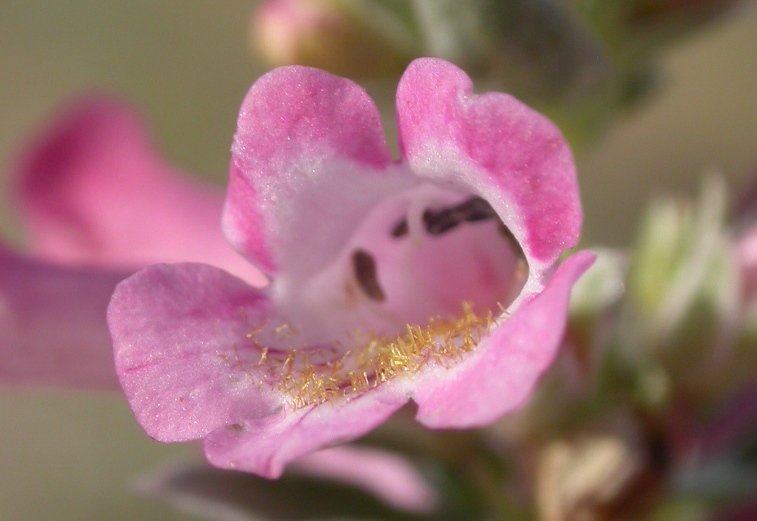
^White-margined beardtongue (Penstemon albomarginatus) (Photo by Jim Andre).
Avian Protection Plan
The Golden eagle is federally protected, and no "take" is allowed, meaning no killing, harming, or disturbing nests. The Bald and Golden Eagle Protection Act prevents anyone from disturbing breeding or foraging areas, as eagles will abandon a territory with too much disturbance.
All of the project site is eagle foraging habitat, where the raptors hunt such prey as rabbits. Golden eagles nest within a few miles of the project as well. US Fish and Wildlife Service requested surveys and analysis of impacts on eagles, but no full investigation was done. A Project Protection Plan needs to be prepared.
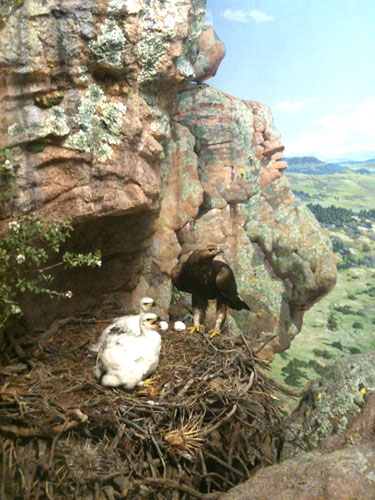
^Golden eagle at nest with chicks on a rocky cliff.
Bighorn Sheep Movement
The project would block a major connectivity corridor for Desert bighorn sheep between the Cady Mountains to the north and Rodman Mountains to the south. No mitigation was offered but artificial water sources in the Cady Mountains.
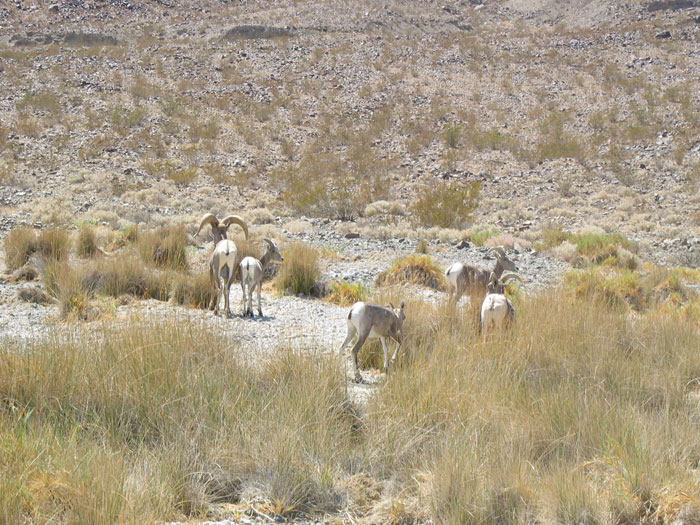
^Bighorn sheep come down to alluvial fans and valley floors to feed.
No Flood Plan
The applicant had also never developed a stormwater and drainage plan nor find the final locations of flood detention basins.
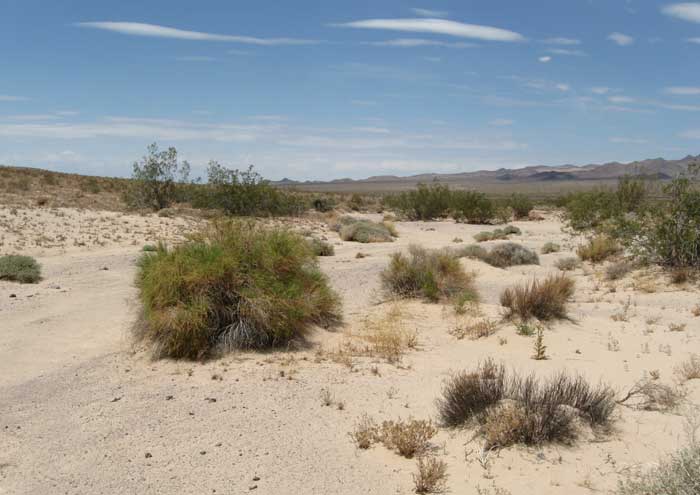
^Large sandy wash on the project site, prone to flash-flooding.
Conclusion
The Sierra Club is asking for the project application to be vacated, but more importantly now that Tessera has sold off the project rights to another company, the petition asks for a stay on all other approvals for this site pending a determination on this decision, and for the CEC to prepare a legally binding decision.
See the Mojave Desert Blog for an excellent summary:
http://www.mojavedesertblog.com/2011/01/sierra-club-lawsuit-targets-calico.html
See also:
http://www.reuters.com/article/idUSTRE70432N20110105
A good story on the complexities of locating utility-scale solar projects currently:
HOME.....Calico Updates
